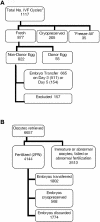Defining human embryo phenotypes by cohort-specific prognostic factors
- PMID: 18596962
- PMCID: PMC2432022
- DOI: 10.1371/journal.pone.0002562
Defining human embryo phenotypes by cohort-specific prognostic factors
Abstract
Background: Hundreds of thousands of human embryos are cultured yearly at in vitro fertilization (IVF) centers worldwide, yet the vast majority fail to develop in culture or following transfer to the uterus. However, human embryo phenotypes have not been formally defined, and current criteria for embryo transfer largely focus on characteristics of individual embryos. We hypothesized that embryo cohort-specific variables describing sibling embryos as a group may predict developmental competence as measured by IVF cycle outcomes and serve to define human embryo phenotypes.
Methodology/principal findings: We retrieved data for all 1117 IVF cycles performed in 2005 at Stanford University Medical Center, and further analyzed clinical data from the 665 fresh IVF, non-donor cycles and their associated 4144 embryos. Thirty variables representing patient characteristics, clinical diagnoses, treatment protocol, and embryo parameters were analyzed in an unbiased manner by regression tree models, based on dichotomous pregnancy outcomes defined by positive serum beta-human chorionic gonadotropin (beta-hCG). IVF cycle outcomes were most accurately predicted at approximately 70% by four non-redundant, embryo cohort-specific variables that, remarkably, were more informative than any measures of individual, transferred embryos: Total number of embryos, number of 8-cell embryos, rate (percentage) of cleavage arrest in the cohort and day 3 follicle stimulating hormone (FSH) level. While three of these variables captured the effects of other significant variables, only the rate of cleavage arrest was independent of any known variables.
Conclusions/significance: Our findings support defining human embryo phenotypes by non-redundant, prognostic variables that are specific to sibling embryos in a cohort.
Conflict of interest statement
Figures


Similar articles
-
Long-term evaluation of implantation of fresh and cryopreserved human embryos following ovarian stimulation with buserelin acetate-human menopausal gonadotrophin (HMG) or clomiphene citrate-HMG.Hum Reprod. 1996 Oct;11(10):2097-106. doi: 10.1093/oxfordjournals.humrep.a019056. Hum Reprod. 1996. PMID: 8943509
-
Guidelines for the number of embryos to transfer following in vitro fertilization No. 182, September 2006.Int J Gynaecol Obstet. 2008 Aug;102(2):203-16. doi: 10.1016/j.ijgo.2008.01.007. Int J Gynaecol Obstet. 2008. PMID: 18773532 Review.
-
[Factors related to occurrence of twin pregnancy after double-embryo transfer in vitro fertilization cycles].Zhonghua Fu Chan Ke Za Zhi. 2009 Jun;44(6):413-7. Zhonghua Fu Chan Ke Za Zhi. 2009. PMID: 19953939 Chinese.
-
Does freeze-all policy affect IVF outcome in poor ovarian responders?Ultrasound Obstet Gynecol. 2018 Oct;52(4):530-534. doi: 10.1002/uog.19000. Epub 2018 Sep 3. Ultrasound Obstet Gynecol. 2018. PMID: 29280508
-
Cryopreservation of human embryos and its contribution to in vitro fertilization success rates.Fertil Steril. 2014 Jul;102(1):19-26. doi: 10.1016/j.fertnstert.2014.05.027. Epub 2014 Jun 2. Fertil Steril. 2014. PMID: 24890275 Review.
Cited by
-
Derivation of human embryonic stem cells using a post-inner cell mass intermediate.Nat Protoc. 2013 Feb;8(2):254-64. doi: 10.1038/nprot.2012.157. Epub 2013 Jan 10. Nat Protoc. 2013. PMID: 23306459
-
Poor prognosis with in vitro fertilization in Indian women compared to Caucasian women despite similar embryo quality.PLoS One. 2009 Oct 26;4(10):e7599. doi: 10.1371/journal.pone.0007599. PLoS One. 2009. PMID: 19855835 Free PMC article.
-
Quality of embryos transferred and progesterone levels are the most important predictors of live birth after fresh embryo transfer: a retrospective cohort study.J Assist Reprod Genet. 2014 Feb;31(2):185-94. doi: 10.1007/s10815-013-0129-4. Epub 2013 Nov 8. J Assist Reprod Genet. 2014. PMID: 24202826 Free PMC article.
-
Influence of group embryo culture strategies on the blastocyst development and pregnancy outcome.J Assist Reprod Genet. 2013 Jan;30(1):63-8. doi: 10.1007/s10815-012-9892-x. Epub 2012 Dec 14. J Assist Reprod Genet. 2013. PMID: 23239126 Free PMC article.
-
Embryo quality before and after surgical treatment of endometriosis in infertile patients.J Assist Reprod Genet. 2009 Mar;26(2-3):69-73. doi: 10.1007/s10815-008-9287-1. Epub 2009 Feb 12. J Assist Reprod Genet. 2009. PMID: 19214735 Free PMC article.
References
-
- Behr B. Blastocyst culture and transfer. Hum Reprod. 1999;14:5–6. - PubMed
-
- Cowan CA, Klimanskaya I, McMahon J, Atienza J, Witmyer J, et al. Derivation of embryonic stem-cell lines from human blastocysts. N Engl J Med. 2004;350:1353–1356. - PubMed
-
- Gardner DK, Lane M, Schoolcraft WB. Culture and transfer of viable blastocysts: a feasible proposition for human IVF. Hum Reprod. 2000;15(Suppl 6):9–23. - PubMed
-
- Milki AA, Hinckley MD, Fisch JD, Dasig D, Behr B. Comparison of blastocyst transfer with day 3 embryo transfer in similar patient populations. Fertil Steril. 2000;73:126–129. - PubMed
-
- Chen H, Qian K, Hu J, Liu D, Lu W, et al. The derivation of two additional human embryonic stem cell lines from day 3 embryos with low morphological scores. Hum Reprod. 2005;20:2201–2206. - PubMed
Publication types
MeSH terms
Grants and funding
LinkOut - more resources
Full Text Sources
Other Literature Sources

